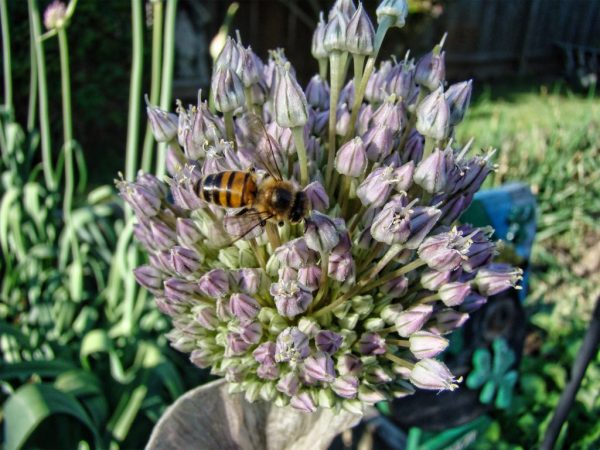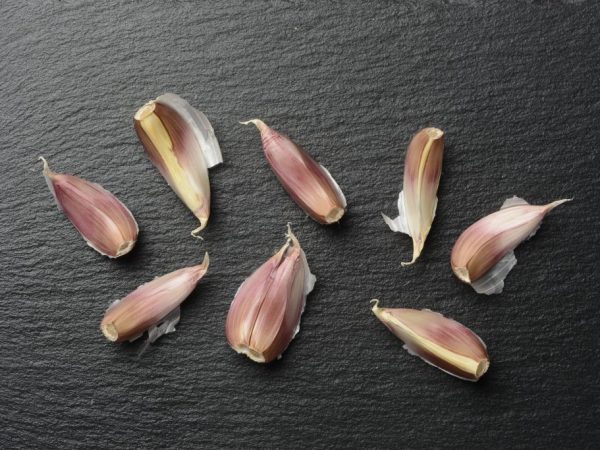Top dressing of garlic in early spring
Top dressing of garlic in spring is an important part of plant care. Most gardeners are engaged in growing this useful plant, but not everyone knows at what time and what types of nutrients the soil needs to be applied in order to get a good harvest. Spring feeding of garlic, like onions, does not require much time and costs, so you should not neglect them in any case.

Top dressing of garlic in early spring
Why feeding is necessary
It often happens that the leaves of winter garlic begin to turn yellow. What causes these processes? Experts point out two main reasons for this phenomenon:
- lack of mineral and organic substances;
- violation of the exchange of air and gases.
The plant begins to turn yellow if the gardener did not feed it in early spring. Is it possible to halt the development of a morbid state of culture? In this case, experts recommend pouring it with a solution of ammonium nitrate (1 tablespoon per bucket of water).
In the second case, it is enough to loosen the soil between the plants with a hoe. Do this every time you water or apply nutrients, or whenever weeds appear.
In order to prevent yellowing of the leaves and a suspension in the growth and development of the culture, it is necessary to fertilize it in a timely manner with mineral and organic substances. This article will discuss the timing and methods of adding nutrients to achieve excellent results.
When to conduct
Top dressing of winter garlic in the spring is carried out three times. In this case, it is necessary to adhere to the following deadlines:
- The first time the nutrients are applied in early spring, just after the soil has cleared of snow.
- The second time - 14 days after the first.
- The last time the introduction of nutrients is carried out at the beginning of summer, at this time the bulb is tied and grows.
The first and second feeding of winter garlic in spring, like onions, can be corrected as needed, it depends on local conditions (weather, soil fertility, etc.). Insignificant deviations will not affect the growth and development of culture.
A significant delay in feeding will stop the growth of the crop, and it will not work to achieve a good harvest. The third feeding is especially important, delaying it or carrying it out too late is highly discouraged.
Substances for feeding
What are the best substances to use for spring dressing of garlic? Experienced gardeners recommend the following fertilization recipes in early spring:
- Urea is used for the first time. A solution is prepared: 1 tbsp. spoon on a bucket of water. This solution is sufficient for 3 m².
- The second time the culture is watered with a solution of nitroammofoska (2 tablespoons per bucket of water). A bucket of mortar is enough for 2 m².
- The third time the culture is fertilized with a superphosphate solution (2 tablespoons per bucket of water). For each m², 5 liters of fertilizer are applied.
You should not rush to apply fertilizers, otherwise the plants will start up all their forces on the growth of the development of the ground part. It is not recommended to fertilize overgrown crops.
Foliar application of nutrients

For a high-quality harvest, you need top dressing
This method is used by experienced vegetable growers and gardeners. They spray the plants with a solution of various fertilizers. The chemical industry produces a large number of different drugs. Using them, you need to carefully follow the instructions and in no case overdo it with the dosage. Concentration for foliar application should be half as much as for root application. The preparations are produced in liquid and dry form, they can be used for both garlic and onions. Treatment with a solution is carried out in the morning or in the evening in calm dry weather.
Ammonia foliar feeding is very useful: 25 ml of ammonia is diluted in a bucket of water. Plants are sprayed with the solution. This allows not only to saturate crops with nitrogen, but also to scare off many pests. Plants are processed in spring and summer: in spring, the plant is enriched with nitrogen, and in summer it will not be afraid of pests.
But this type of nutrient introduction does not exclude three root nutrients, it acts as an attachment to them. All experienced gardeners are engaged in fertilizing garlic in the spring.
Folk remedies
Ash is a universal fertilizer; it has been used for most cultivated plants since ancient times. Our ancestors noticed that crops grow better in areas where fires were previously made. You can use the substance in dry form: sprinkle rows of ash between the plants, and then water. Some gardeners prepare the following solution: dissolve a glass of the substance in a bucket of water. The aisles are poured with a ready-made solution, and then the soil is loosened.
Manure and droppings
Root treatment with winter garlic and onion ash should be alternated in summer with solutions of manure and poultry droppings. In no case should dry manure be used, it can burn the plantings. The manure solution is prepared in the following way:
- manure is poured into a large barrel and poured with water in a ratio of 1: 5;
- cover the container, stirring the fermenting liquid from time to time.
After two weeks, the solution is ready and you can fertilize the soil with it. A liter of slurry is added to a bucket of water and the aisles are watered. A bucket of mortar is used for each m².
A solution of poultry manure and water is prepared in a ratio of 1:15. A more concentrated solution is not allowed, as it can burn the cultures. Organic matter must be introduced carefully, under the root, it should not fall on the leaves. Such methods of applying nutrients will bring an excellent harvest. It is not recommended to add fresh manure to the garden bed. From this, the culture is affected by worms and other pests, the larvae of which are in the manure.
Deciduous humus
A good folk remedy for yellowing leaves, which is evidence of a lack of nutrients, is a salt solution: 3 tbsp. spoons in a bucket of water. The solution is poured over the culture, using in an amount of 3 liters per m². This tool, in addition to enriching crops with sodium and chlorine, also disinfects the earth. It destroys the larvae of the stem nematode and filamentous worms, which hibernate in the ground, teeth and infect the plant.
Conclusion
Of course, spring dressing of garlic favorably affects the growth of culture and the size of the bulb. In no case should you overdo it with the amount of nitrogen, otherwise the heads of garlic will be affected by cervical rot during storage and most of them cannot be saved. A good harvest depends not only on the amount and time of nutrients introduced.
Garlic loves fertile and non-acidic soil. The growth and development of the culture also depends on the quality of the seed: only healthy, selected teeth will grow an excellent head. If you follow all the rules, the harvest of garlic will be excellent.

